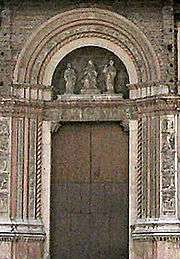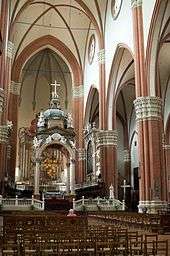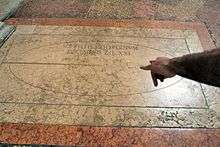San Petronio Basilica

The Basilica of San Petronio is the main church of Bologna, Emilia Romagna, northern Italy. It dominates Piazza Maggiore. It is the tenth-largest church in the world by volume, 132 metres long and 66 metres wide, while the vault reaches 45 metres inside and 51 metres in the facade. With its volume of 258,000 m³, it is the largest (Gothic or otherwise) church built of bricks in the world.[1]
The basilica is dedicated to the patron saint of the city, Saint Petronius, who was the bishop of Bologna in the fifth century. The construction was a communal project of Bologna, not of the bishops: the property was a symbol of communal power that was not transferred from the city to the diocese until 1929; the basilica was finally consecrated in 1954. It has been the seat of the relics of Bologna's patron saint only since 2000; until then they were preserved in the Santo Stefano church of Bologna.
Architecture

Following a council decree of 1388, the first stone of construction was laid June 7, 1390, when the town council entrusted Antonio di Vincenzo with raising a Gothic cathedral. In order to make room for this monumental construction, the adjacent Curia of Sancti Ambrosii was demolished, together with the majority of one of the city's burgs, including at least eight churches and towers. Works lasted for several centuries: after the completion of the first version of the facade, in 1393 the first pair of side chapels were begun. The series were completed only in 1479.

However, in 1514 Arduino degli Arriguzzi proposed a revised plan in the form of a Latin cross with the intent to outdo even Saint Peter's Basilica of Rome, the greatest church of the Western Christian world even in its ancient version. According to tradition, Pope Pius IV halted such a majestic project.
The facing of the main facade remains unfinished: many architects (notably Baldassarre Peruzzi, Vignola, Andrea Palladio and Alberto Alberti) were commissioned to propose solutions for it, but a definitive one was never found. Jacopo della Quercia of Siena enriched the main doorway with sculptures (illustrated, left) and two new small flanking doorways, with subjects taken from the Old Testament, forming a traditional prelude to the new dispensation that is represented by the basilica itself. The heroic nudes of Adam and other figures in the rectangular bas-relief panels were an inspiration to artists of the Renaissance. The 65-metre-tall (213 ft) campanile was built at the end of the 1400s.
Interior

The interior houses a Madonna with Saints by Lorenzo Costa the Younger and a Pietà by Amico Aspertini. Also the colours of the walls and the stained glass windows are noteworthy. The choir was made in the 15th century by Agostino de' Marchi, while the ciborium is a work by Vignola.
Jacopo Barozzi da Vignola was chief architect of the fabbrica; his is the design of the ciborium over the altar. The vaulting and decoration of the central nave is by Girolamo Rainaldi, who completed them in 1646-1658. The twenty-two chapels are the following:
- I. Chapel of St. Abbondio, formerly of the Dieci di Balia - restored in neo-Gothic style in 1865. In this chapel, in the year 1530, Emperor Charles V was crowned by Pope Clement VII.
- II. Chapel of St. Petronio, once of the Cospi and Aldrovandi families, designed by Alfonso Torreggiani, designed to contain the relic of the head of San Petronio.
- III. Chapel of St. Ivo, Formerly of the family of San Brigida dei Foscherari: it has statues of Angelo Piò and the paintings of the Madonna of St. Luke and Saints Emidio and Ivo by Gaetano Gandolfi and Apparition of the Virgin to St. Francesca Romana by Alessandro Tiarini (1615). On the pillar, two clocks, one of the first made in Italy with the correction of the pendulum (1758).
- IV. Chapel of the Magi, once of Bolognini family: its marble Gothic balustrade designed by Antonio di Vincenzo (1400); the Triptych wooden altar with twenty-seven figures carved and painted by Jacopo di Paolo. The walls were painted by Giovanni di Pietro Falloppi/Giovanni da Modena with a cycle depicting the Episodes in the life of San Petronio, the back wall, right wall, Stories of the Three Kings; the left wall, at the top,The Last Judgment with the Coronation of the Virgin in oval, and the controversial Heaven and Hell, Dante's depiction of the places, with a gigantic figure of Lucifer.
- V. Chapel of St. Sebastian, once of Vaselli family..
- VI. Chapel of St. Vincent Ferrer, formerly of the Griffoni, and Cospi-Ranuzzi families: bronze monument of Cardinal Giacomo Lercaro made by Giacomo Manzù (1954).
- VII. Chapel of St. James, formerly of the Rossi and Baciocchi families: the Madonna Enthroned on the altar was painted by Lorenzo Costa (1492), to the same author attributed the designs of the stained glass. Funeral monument containing the remains of Prince Felix Baciocchi and his wife Elisa Bonaparte (1845).
- VIII. Chapel of St. Rocco, formerly of the Ranuzzi family: it contains a San Rocco by Parmigianino (1527).
- IX. Chapel of St. Michael formerly of the Barbazzi and Manzoli families: it houses a painting of Archangel Michael defeating the Fallen Angels by Donato Creti (1582).
- X. Chapel of St. Rosalie, formerly of the Sixteen of the Senate, now the Town Hall: canvas of Glory of Santa Barbara by Tiarini.
- XI. Chapel of St. Bernardino stands before the fifteenth-century organ case by Lorenzo da Prato, the chapel was painted in 1531 by Aspertini with Four Stories of St. Petronius.
- Main Chapel: the altar contains a 15th-century wooden crucifix. At the back, a fresco of the Madonna with St. Petronio by Marcantonio Franceschini and Luigi Quaini, cartoons by Cignani (1672). The ciborium of the main altar was built in 1547 by Vignola. The fifteenth-century wooden choir was completed by Agostino de 'Marchi.
- XII. Chapel of the Relics, formerly of Zambeccari family.
- XIII. Chapel of St. Peter Martyr, formerly the Society of Beccari, with marble railing by Francesco di Simone (late fifteenth century);
- XIV. Chapel of St. Anthony of Padua, formerly of Saraceni and Cospi families: the statue of St. Anthony of Padua attributed to Jacopo Sansovino.
- XV. Chapel of the Blessed Sacrament, formerly of the Malvezzi Campeggi, rebuilt in the nineteenth.
- XVI. Chapel of the Immaculate, formerly of Fantuzzi family: art nouveau decorations by Achille Casanova.
- XVII. Chapel of St. Jerome, formerly of the Castelli: the St. Jerome altar attributed to Lorenzo Costa.
- XVIII. Chapel of St. Lorenzo, formerly of the Garganelli, Ratta and Pallotti families: the Pieta was painted by Aspertini.
- XIX. Chapel of the Cross, formerly of the Notai: with devotional frescoes depicting Saints by Francesco Lola, Giovanni Pietro Falloppi and Pietro Lianori (XV). The window was made by Blessed Fra Giacomo di Ulm designed by Michele di Matteo da Bologna.
- XX. Chapel of St. Ambrose, formerly of the Marsili, with a fresco in the style of Vivarini (mid-15th century).
- XXI. Chapel of St. Bridget, formerly of the Pepoli: polyptych by Tomas Garelli (1477).
- XXII. Chapel of Our Lady of Peace: Madonna in Istrian stone by Giovanni Ferabech (1394).
Music
Bologna was a principal centre of Baroque music in Italy. The musical organisation had been officially instituted by Pope Eugenius IV in 1436; the first regularly paid instrumentalists were added in the late sixteenth century, and in the seventeenth century San Petronio was renowned for its sacred instrumental and choral music, with its two great organs, completed in 1476 and 1596, both still in remarkably original condition; the library remains a rich archival repository. Three successive maestri di cappella marked the great age of music at San Petronio: Maurizio Cazzati (1657–71), Giovanni Paolo Colonna (1674–95) and Giacomo Antonio Perti (1696–1756).[2] The current maestro, since 1996, is the harpsichordist Sergio Vartolo who has revitalised the cappella with a series of recordings for Naxos, Tactus, Brilliant Classics and Bongiovanni.
Cassini's Meridian Line

The church hosts also a marking in the form of a meridian line inlaid in the paving of the left aisle in 1655; it was calculated and designed by the astronomer Giovanni Domenico Cassini, who was teaching astronomy at the University. A meridian line does not indicate the time, but instead the day of the year, as well as determining the length of the solar year. At 66.8 metres (219 ft) it is one of the largest astronomical instruments in the world, allowing measurements that were for the time uniquely precise; Cassini and Domenico Guglielmini published an illustrated account of how the meridian was accomplished in 1695.[3]
Notable events

Middle Ages
Pope Clement VII chose it for the coronation of Charles V in 1530. Elisa Bonaparte, Napoleon Bonaparte's sister, is buried here.
Modern planned terrorist attacks
In 2002, five men who it was believed were connected to Al Qaeda and were planning to blow up the building, were arrested.[4][5] Again in 2006, plans by Muslim terrorists to destroy the Basilica were thwarted by Italian police. The terrorists claimed that a 15th-century fresco inside was insulting to Islam. The fresco, painted by Giovanni da Modena, depicts Muhammad in Hell being devoured by demons.[6][7]
See also
- Bolognese bell ringing art, which was conceived and created in the Basilica's bell tower
- Santa Maria degli Angeli e dei Martiri, whose meridian line Pope Clement XI commissioned to rival Bologna's
- Palazzo dei Banchi
- Palazzo d'Accursio
- Palazzo del Podestà, Bologna
- Palazzo dei Notai
Notes
- ↑ data from http://www.bolognawelcome.com, Basilica di San Petronio plus calculations as follows:
- San Petronio de Bologna: The footplan of the building is a simple rectangle
- Area = length of the building x width of the building = 132 m x 60 m
- The volume, without the roofs, can be calculated as a sum of five cuboids, one single (the central nave) and two pairs (the aisles and the files of chapels). The sum each of the pairs can be calculated as one cuboid of double width. Knowing the height of the central nave and the width of the building, the measures of the sections can be calculated by measuring an orthograde photo of the facade.
- Volume = (traverse section of the central nave [width = 22 m, height = 44.27 m] + sum of the traverse sections of the two aisles [width = 20 m, height = 29.06 m] + sum of the traverse sections of the two files of chapels [width = 18 m, height = 22.38 m]) x length of the building [132 m]
- (973.94 + 581.2 + 402.84) x 132 = 1,957.98 x 132 = 258,453.36
- San Petronio de Bologna: The footplan of the building is a simple rectangle
- ↑ Anne Schnoebelen, "Performance Practices at San Petronio in the Baroque" Acta Musicologica 41.1/2 (January 1969), pp. 37-55; see also Eugene Enrico, The Orchestra at San Petronio in the Baroque Era (Washington: Smithsonian Studies) 1976.
- ↑ Recently, the book was edited by Giordano Berti and Giovanni Paltrinieri, La Meridiana del Tempio di S. Petronio in Bologna, Arnaldo Forni Editore, S. Giovanni in Persiceto, 2000. Paltrinieri is also the author of a booklet that summarises the work of Cassini and Guglielmini; La meridiana di San Petronio Archived 2007-01-31 at the Wayback Machine.
- ↑ "Italy arrests men over 'church plot'". BBC News. August 20, 2002. Retrieved May 23, 2010.
- ↑ Bruni, Frank (August 21, 2002). "Italy Arrests 5; Fresco Showing Muhammad Is Issue". The New York Times. Retrieved May 23, 2010.
- ↑ News article Archived 2006-04-12 at the Wayback Machine.
- ↑ Philip Willan (June 24, 2002). "Al-Qaida plot to blow up Bologna church fresco". London: The Guardian.
Sources
- Heilbron, J.L. (2001). The sun in the church: cathedrals as solar observatories. Harvard University Press. ISBN 978-0-674-00536-5.
External links
| Wikimedia Commons has media related to Basilica di San Petronio (Bologna). |
Coordinates: 44°29′34″N 11°20′37″E / 44.49278°N 11.34361°E